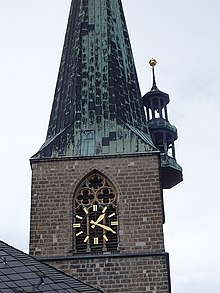seiger
The adjective seiger (or saiger ) [ ˈzaɪ̯.ɡɐ ] is a term used in mining and geology mostly synonymous for vertical , perpendicular or vertical , which is used to describe the spatial location of mining or geological conditions in more detail. For example, in mining a vertical shaft is called a Seigerer shaft , in geology the vertical position of a cleft is called a Seigerer cleft . In contrast, a barrel-length shaft deviates from the vertical and leads down at an angle. Accordingly, a Seigerriss is a vertical sectional drawing ( elevation ) through a mine.
use

The nouns "Saigern" / "Seigern", "Absaigern" / "Abseigern", as well as the verb "saigern" / "seigern" / "Absaigern" / "Abseigern" describe processes of sinking of components of a melt mixture with a specifically higher weight than such with specifically lighter weight components, such as B. in magma chambers (see differentiation of magmas), during the formation of the earth or the formation of the shell structure of the earth.
The usual names in mining for slopes from vertical to horizontal are:
- seiger (> 75-90 degrees ).
- tonnage (45-75 degrees),
- gently falling (steeper than 15 degrees)
- floating or flat (may have a slight gradient for better water flow),
- totsöhlig (precisely horizontal).
In some areas in Central Germany, the clock is also known colloquially as Seiger or Saiger. This designation, which was originally used for tower clocks, goes back to the early New High German word seiger for balance and is derived from the horizontally swinging balance bar of these clocks.
See also
Web links
Individual evidence
- ↑ Kluge: Etymological dictionary of the German language. 23rd edition. De Gruyter, 1999, p. 755.
literature
- Walter Bischoff , Heinz Bramann, Westfälische Berggewerkschaftskasse Bochum: The small mining dictionary. Glückauf Verlag, Essen 1988, ISBN 3-7739-0501-7 .
- Hans Murawski : Geological Dictionary. 8th edition. Enke, Stuttgart, ISBN 3-432-84108-6 , p. 187.
